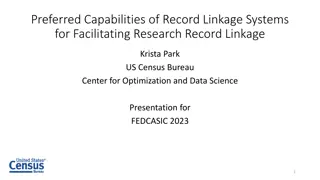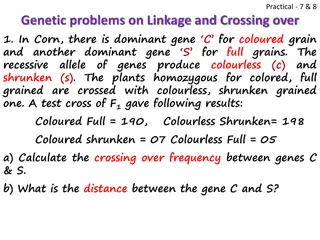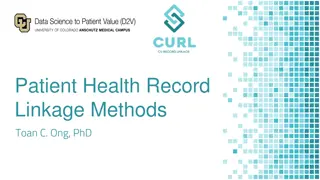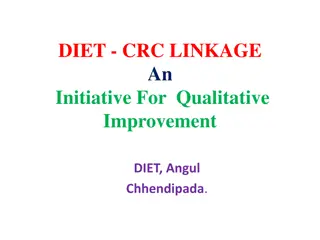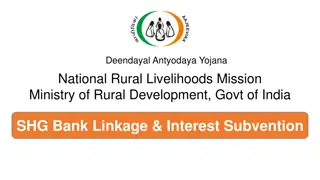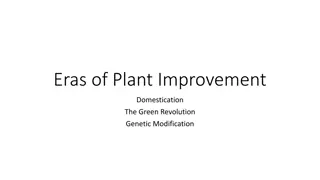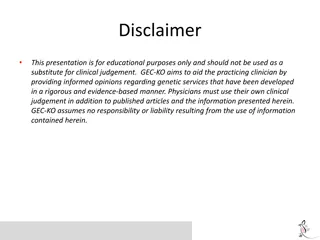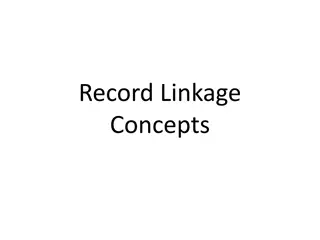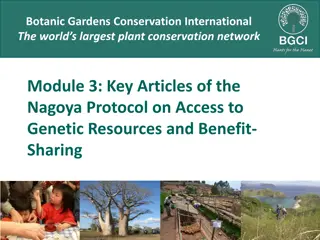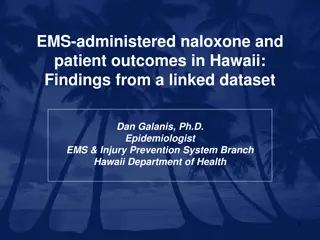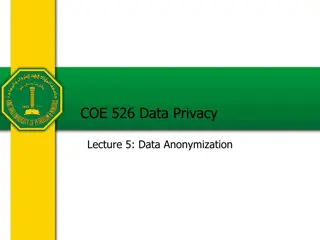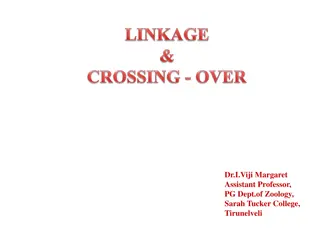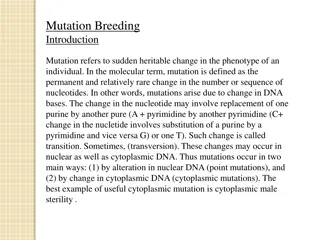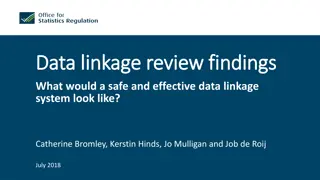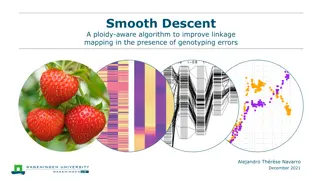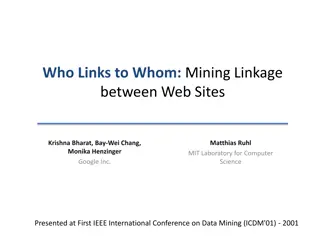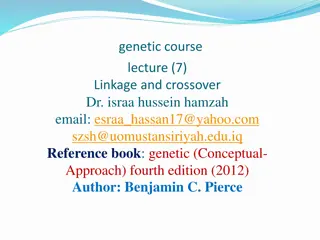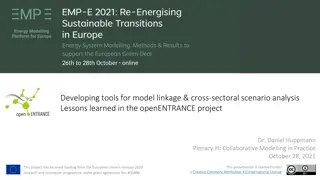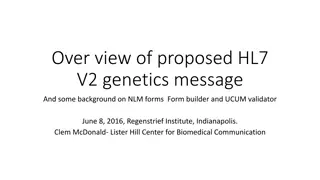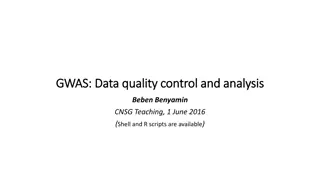Drug Patent Linkage System of China
Analysis of China's drug patent linkage system, including the recent fourth amendment of the Chinese Patent Law and the regulations and measures governing early resolution of drug patent disputes. It covers the eligible patents for registration, patent statements, the bifurcated judicial and adminis
5 views • 14 slides
Genetic Testing in Chronic Kidney Disease (CKD): Insights and Applications
Genetic testing plays a crucial role in identifying inherited kidney diseases, with around 15% of CKD cases having monogenic causes. Despite a high percentage of patients reporting a family history of CKD, Mendelian causes only account for about 10% of adult ESRD cases. Understanding the genetic bas
1 views • 52 slides
Social Network-Based Intervention Improves HIV Testing and Linkage Among Fishermen in Kenya
In sub-Saharan Africa, a study was conducted among Lake Victoria fishermen in Kenya to assess the effectiveness of a social network-based intervention in improving HIV testing and linkage outcomes. Results showed significantly higher rates of HIV self-testing and linkage to health facilities in the
0 views • 19 slides
Preferred Capabilities of Record Linkage Systems for Research
This presentation by Krista Park from the US Census Bureau explores the preferred capabilities of record linkage systems in facilitating research. It includes disclaimers, details about the researcher stakeholder team, coordination, leadership oversight, and the outline of the linkage process. The f
4 views • 17 slides
Overview of Human Genetic Disorders
Human genetic disorders encompass a range of conditions, from recessive disorders like cystic fibrosis to dominant disorders such as Huntington's disease. Examples include cystic fibrosis, Huntington's disease, and sickle-cell anemia. Understanding genetic disorders involves research and awareness o
0 views • 10 slides
Genetic Linkage and Crossing Over Problems in Various Organisms
This content presents genetic problems on linkage and crossing over in different organisms such as corn, tomato, Drosophila, and rabbits. It describes the traits involved, crosses performed, and results obtained to calculate crossing over frequencies and distances between linked genes. The examples
0 views • 8 slides
Understanding Patient Health Record Linkage Methods
Explore the methods and processes involved in linking patient health records to ensure data accuracy and integrity. Learn about objectives, data de-duplication, encryption, data normalization, and linkage variables. Discover CU Record Linkage (CURL) data flow and key quality measures. Dive into data
2 views • 21 slides
Exploring Genetic Engineering: From Basics to Applications
Genetic engineering involves altering the genetic material of organisms to achieve desirable traits. This process entails cutting out specific genes from one organism and transferring them to another. In medicine, genetic engineering finds applications in gene therapy, hormone production, and vaccin
0 views • 12 slides
Understanding Genetic Markers in Molecular Mapping
Genetic markers play a crucial role in gene mapping within molecular biotechnology. They are fragments of DNA associated with specific genomic locations, aiding in identifying DNA sequences and analyzing genetic variation. Various types of genetic markers such as RFLP, SSR, and SNP offer insights in
1 views • 26 slides
Understanding Genetics: Mutations, Chromosomal Aberrations, and Genetic Engineering
Genetic mutations can be harmless, harmful, or beneficial, leading to variations within a species. Examples of gene mutations and chromosomal aberrations, like Trisomy 21, illustrate genetic abnormalities. The increase in Down Syndrome cases with maternal age highlights a maternal age effect. Geneti
0 views • 17 slides
Exploring Genetic Engineering: A Journey into Manipulating Organisms
Delve into the world of genetic engineering, where organisms' genetic makeup is altered for various purposes. Discover the process of modification, the history of genetic manipulation, and the impact of genetically modified organisms on society and science.
0 views • 20 slides
Improving Microbial Productivity and Characteristics for Industrial Applications
Efforts to enhance the productivity of natural isolates for commercial products involve genetic modifications through mutation, genetic recombination, and genetic engineering techniques. Desired characteristics include genetic stability, efficient production, versatility in carbon sources, and ease
1 views • 25 slides
Enhancing Teacher Capacity Building Through DIET-CRC Linkage Initiative
The DIET-CRC Linkage Initiative aims to strengthen CRCs academically for teacher capacity building programs and continuous professional development. It focuses on developing cluster-specific plans, fostering knowledge-sharing, and enhancing academic support at grassroots levels. The vision includes
0 views • 16 slides
Overview of Deendayal Antyodaya Yojana National Rural Livelihoods Mission
Deendayal Antyodaya Yojana is a national rural livelihoods mission under the Ministry of Rural Development, Government of India. It focuses on Self-Help Group (SHG) Bank Linkage and Interest Subvention to support rural development. The NRLM SHG Bank Linkage Portal facilitates the monitoring of SHG B
2 views • 39 slides
Classification and Genetic Defects of Diabetes
The diagnosis and differential diagnosis of Type 1 and Type 2 diabetes are discussed, detailing the clinical courses, age of onset, body weight characteristics, onset patterns, and genetic factors. The etiologic classification of diabetes including insulin-deficient, immune-mediated, monogenic, and
0 views • 16 slides
Evolution of Plant Improvement: Domestication to Genetic Modification
Plant improvement has evolved through different eras - from ancient domestication to the Green Revolution and genetic modification. Domestication shaped major crops over millennia, the Green Revolution introduced high-yielding varieties, and genetic modification allows direct genetic alterations for
0 views • 6 slides
Genetic Manipulation in Environmental Biotechnology
Genetic manipulation strategies in environmental biotechnology involve techniques like gene splicing and molecular cloning to modify genes directly. These methods have various applications such as isolating genes, producing specific molecules, improving biochemical production, creating organisms wit
0 views • 20 slides
Understanding ARC Linkage 2014 Session: Tips and Insights
Delve into the nuances of ARC Linkage 2014 Session presented by Rose Firkin and Greg Pullen from Deakin University. Discover reasons leading to up to 12 months negotiation time for Linkage agreements, including partner organizations' lack of awareness, IP provision disagreements, and collaborator co
0 views • 25 slides
Understanding Bacterial Transformation in Molecular Biology
Transformation in molecular biology is a process where genetic material is altered by the uptake of exogenous DNA. It involves the direct incorporation of genetic material into a cell, leading to genetic changes. This phenomenon was first demonstrated by Frederick Griffith in 1928. The process of tr
1 views • 25 slides
Understanding Genetic Counselors and the NSGC
Genetic counselors play vital roles in healthcare by assisting patients with genetic conditions, advocating for their needs, educating providers, conducting research, and influencing public policy. The National Society of Genetic Counselors (NSGC) supports genetic counselors in their professional en
3 views • 12 slides
Genetic Carrier Screening for Recessive Disorders by GENDIA, Antwerp, Belgium
Explore the world of genetic carrier screening offered by GENDIA in Antwerp, Belgium. Learn about prenatal screening for various genetic disorders, including Down syndrome and severe monogenic disorders. Discover the frequency of common recessive disorders and the severity of genetic diseases. Uncov
0 views • 17 slides
Exploring Expanded Carrier Screening in Family Planning
Learn about expanded carrier screening as a tool for identifying genetic risks in family planning scenarios. Understand the importance of genetic testing, considerations for non-consanguineous couples like Julie and Chris, and the evolving landscape of genetic services. Explore key aspects such as f
1 views • 36 slides
Understanding Record Linkage Concepts
Explore the fundamentals of record linkage, also known as matching or merging, which involves combining data from different sources for the same individual. Learn about the importance of efficient and accurate duplicate detection, deterministic matching, and the challenges of variations in data betw
3 views • 20 slides
Understanding the Key Articles of the Nagoya Protocol on Access to Genetic Resources and Benefit-Sharing
The Nagoya Protocol aims to promote fair sharing of benefits from genetic resources utilization for conservation efforts. It encompasses access, technology transfer, funding, and respect for rights over resources and technologies. The protocol applies to genetic resources, traditional knowledge, and
1 views • 19 slides
EMS-Administered Naloxone and Patient Outcomes in Hawaii: Epidemiological Study
This study presents findings from a linked dataset analyzing EMS-administered naloxone and patient outcomes in Hawaii from 2012-2016. Part 1 covers basic epidemiological descriptions and linkage to hospital billing data, while Part 2 investigates associations between EMS response times and patient o
0 views • 14 slides
Data Privacy in Sharing Sensitive Information
Understanding the importance of data anonymization and privacy requirements in sharing data. Exploring methods like k-anonymization and issues such as data linkage attacks that compromise individual privacy. Highlighting real-life examples like the MA governor's data linkage incident and the Netflix
0 views • 38 slides
Understanding Linked Genes and Genetic Mapping in Inheritance
Linked genes inherited together on chromosomes influence genetic traits. Discover the differences between sex-linked and linked genes, the concept of crossing over, linkage mapping, and the significance of gene distance in recombination. Explore the work of Alfred Sturtevant in gene mapping through
0 views • 21 slides
Luxembourg's Approach to Testing and Linkage to Care in Prison Settings
Luxembourg's approach to testing and linkage to care in prison settings is comprehensive and involves thorough medical services, including somatic medicine and psychiatric care. The system ensures that every inmate is seen by a medical doctor within 24 hours, undergoes blood tests, receives appropri
0 views • 14 slides
Florida Linkage Institutes: Securing International Students for In-state Tuition
The Florida Linkage Institutes program, established in 1986 by the Florida Legislature, facilitates educational and social exchanges between Florida and various foreign countries. It offers tuition exemptions for international students from select countries studying at Florida community colleges and
0 views • 10 slides
Evolutionary Computation and Genetic Algorithms Overview
Explore the world of evolutionary computation and genetic algorithms through a presentation outlining the concepts of genetic algorithms, parallel genetic algorithms, genetic programming, evolution strategies, classifier systems, and evolution programming. Delve into scenarios in the forest where gi
0 views • 51 slides
Understanding Genetic Linkage in Maize and Drosophila
The concept of genetic linkage is explored through experiments in maize and Drosophila, showcasing how specific traits are inherited together due to their close association on chromosomes. In maize, the phenomenon of linkage is demonstrated through color and endosperm traits, while in Drosophila, co
0 views • 11 slides
Understanding Mutation Breeding in Crop Plants
Mutation breeding involves inducing heritable changes in crop plants through mutations, leading to genetic improvements for economic traits. This method is valuable when desired variability is lacking, for correcting genetic defects, overcoming linkage issues between desirable and undesirable traits
0 views • 22 slides
Enhancing Data Linkage Systems for Safe and Effective Information Sharing
Data linkage plays a crucial role in answering society's questions, but current processes can be lengthy and inefficient. The key to a safe and effective data linkage system lies in engaging the public, advocating for safe data use, and harmonizing information governance across governmental and stat
0 views • 13 slides
Smooth Descent: A Ploidy-Aware Algorithm for Improved Linkage Mapping
Introducing Smooth Descent, an algorithm designed to enhance linkage mapping accuracy in the presence of genotyping errors. This algorithm iteratively eliminates errors to refine map order, accommodating various marker types and ploidies. By predicting and detecting errors in Identity by Descent (IB
0 views • 12 slides
Linkage Analysis of Web Sites: Understanding the Macro-Structure
This paper explores the hierarchical graph structure of the web, emphasizing the linkage between web sites at various levels of affiliation and control. The authors discuss the connectivity properties of hosts and domains over time using a hostgraph model and propose a related host finding algorithm
0 views • 33 slides
Understanding Linkage and Crossover in Genetics
Genes determining individual characteristics are carried in chromosomes, with some genes linked and inherited together. This linkage affects how genes assort in offspring, following principles of inheritance like Mendel's laws. The Chromosome Theory of Linkage explains how the distance between genes
0 views • 24 slides
Lessons Learned in Model Linkage & Cross-Sectoral Scenario Analysis
The openENTRANCE project under the Horizon 2020 initiative focuses on developing an open, transparent, and integrated modelling platform for evaluating low-carbon transition pathways in Europe. Insights reveal the importance of open-source collaboration and timely development of model-linkage workfl
0 views • 12 slides
Overview of HL7 V2 Genetics Messaging and LOINC Genetic Testing Codes
This content delves into the proposed HL7 V2 genetics message, NLM forms builder, UCUM validator, and the current state of genetic testing codes in LOINC. It discusses the types of molecular genetic tests present in LOINC and the evolution towards newer genetic tests. The content also covers how LOI
0 views • 21 slides
Housing Affordability Agenda Progress Update
This update covers key legislative actions and timelines related to the Housing Affordability and Livability Agenda (HALA) in Seattle. It includes resolutions on Mandatory Inclusionary Zoning (MIZ), Commercial Linkage Fee (CLF), and upcoming public hearings and votes. The agenda aims to establish af
0 views • 6 slides
Understanding GWAS: A Brief Overview of Genetic Association Studies
GWAS, or Genome-Wide Association Studies, are a method used to map genes associated with traits or diseases by analyzing genetic markers throughout the genome. This process involves statistically testing the association between SNPs and traits using regression or chi-squared tests in a hypothesis-fr
0 views • 19 slides



